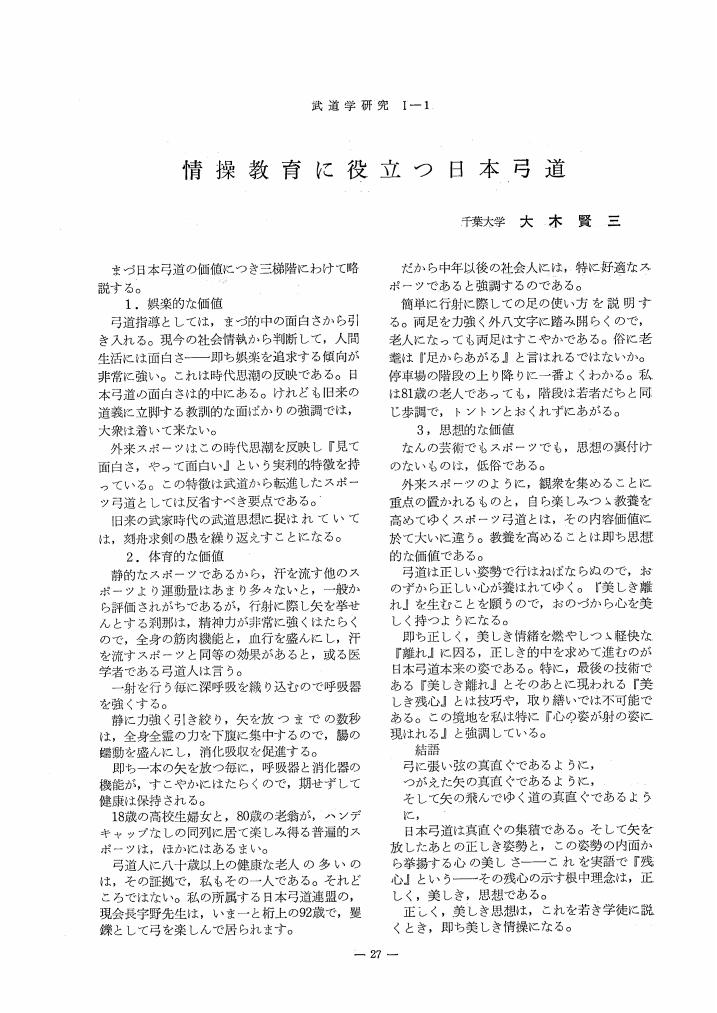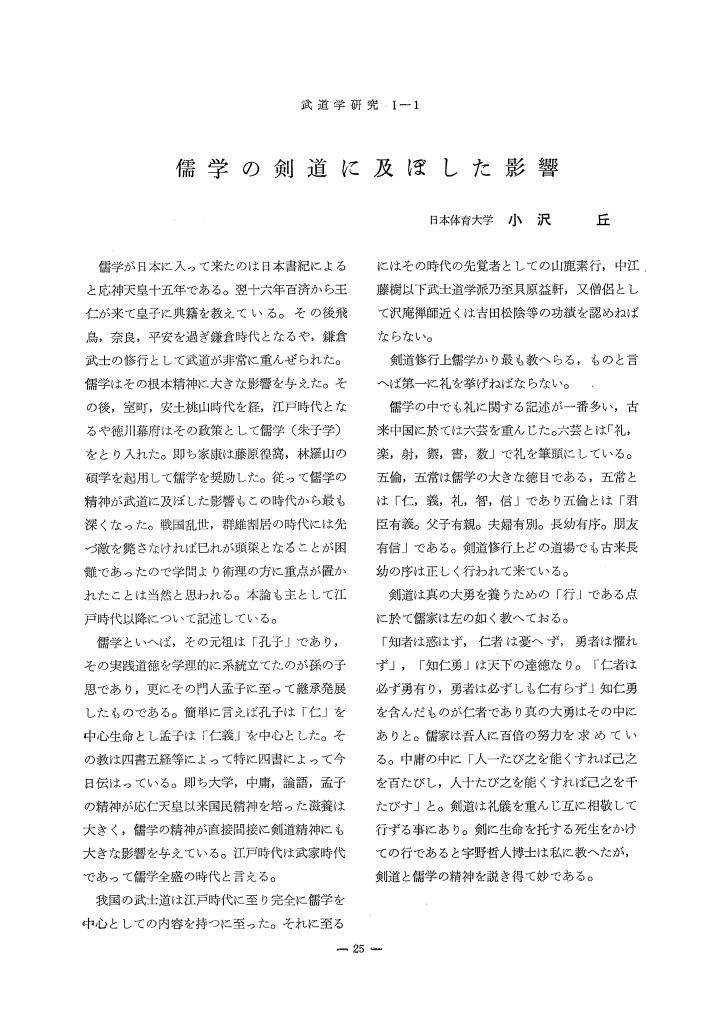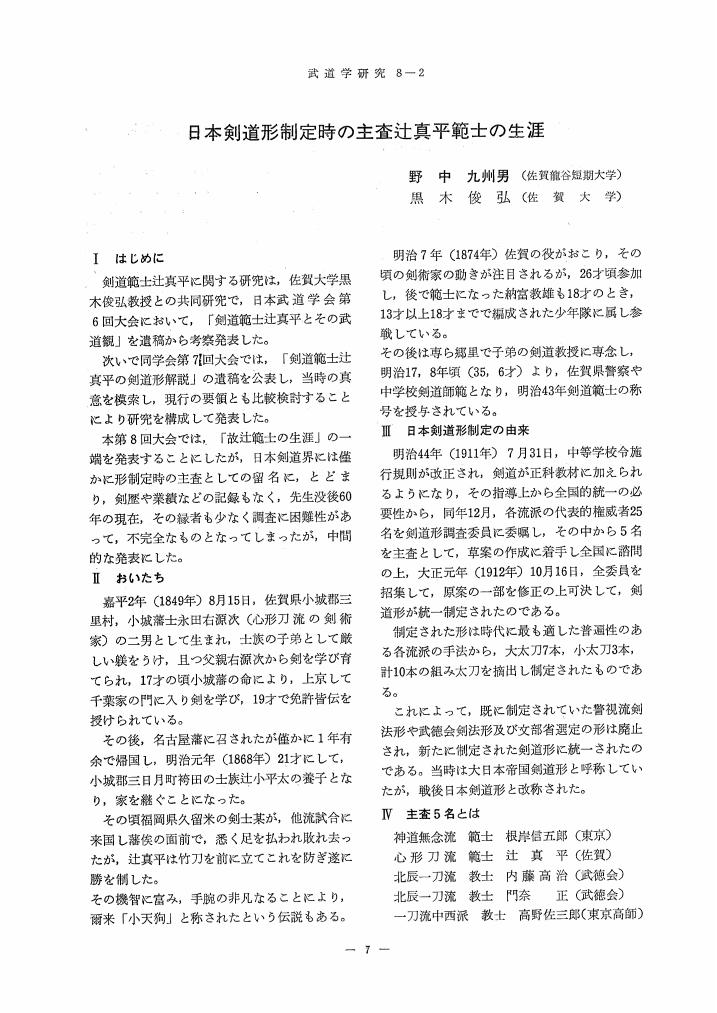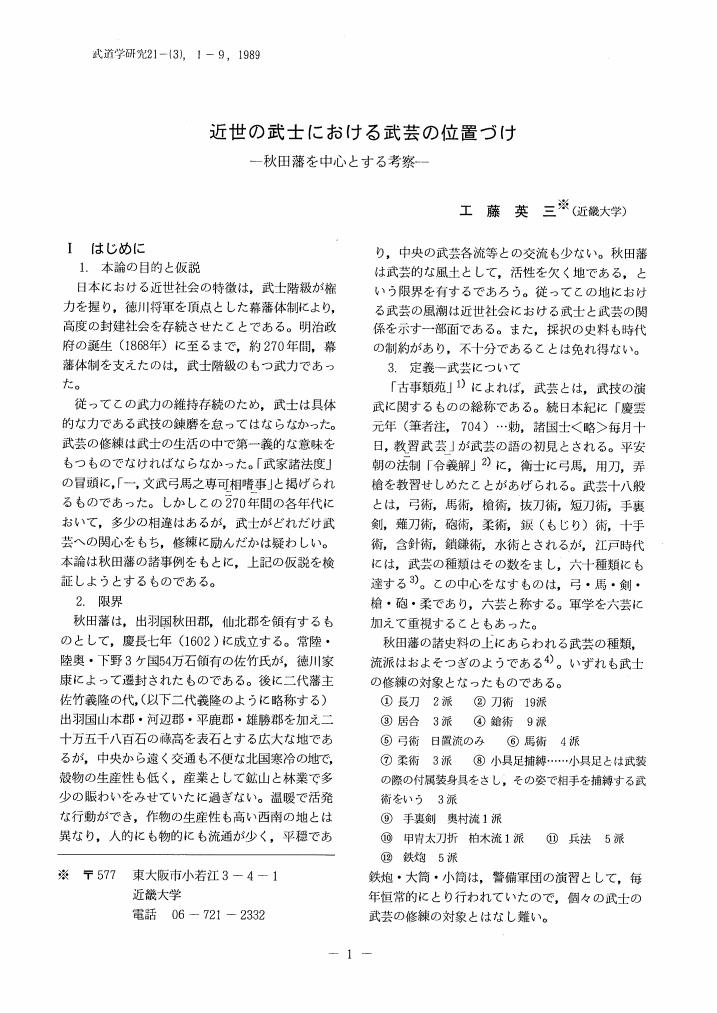4 0 0 0 OA 「満洲国」建国大学に於ける騎道教育
- 著者
- 志々田 文明
- 出版者
- 日本武道学会
- 雑誌
- 武道学研究 (ISSN:02879700)
- 巻号頁・発行日
- vol.34, no.3, pp.1-12, 2002-03-31 (Released:2012-11-27)
- 参考文献数
- 30
The purpose of this study is to clarify the actual conditions of the equestrian education introduced as extracurricular activities and part of the physical exercises, a requirement at Kenkoku University (1938-1945) in Manchukuo. The results can be summarized as folows:1. Equitation training, which was caled as kido, as part of the physical exercise program began in August,1938 it was the year when the university was established. Kido was conducted by Shiratori, an officer in Manchukuo, or Matsuoka, a jokyo-rank instructor. Students were divided into year-groups, and about ten training sessions were held during the first three years to help students have cultural experience in Manchukuo. There might have been a hundred and several dozen horses prepared for the classes.2. Hisaya Ogura, the first-term student at the university, established the equestrian club and led members with his own philosophies until he graduated in 1943. According to Moriguchi Kenji, the second-term student, there were ten to 25 students. Almost all of them were Japanese. Most of them seemed to have joined the club to learn a new skill, which was easier than Japanese martial arts although some members like Ogura tried to take on equestrian very seriously. The activities were not always hard, and the emphasis was on individual student's autonomy just in the same way as in other clubs.3. The word kido during that period had the meaning of attaining the state of selflessness through practice in addition to the mastery of horse riding'skill. In other words, kido was almost like a Japanese budo. Ogura suggested that members learn a spiritual discipline like Zen Buddhism. But at the same time he encouraged his students to join the club as part of the dormitory life, because it was the place for students from five different races to live together in harmony. Ogura's movement was significant even from a universal point of view in that he tried to prepare his students to serve purposes in society, instead of just teaching them horseback riding as a sport to let off steam.
4 0 0 0 OA 寳藏院流の創流及び伝系の分類に関する研究
- 著者
- 石川 哲也
- 出版者
- 日本武道学会
- 雑誌
- 武道学研究 (ISSN:02879700)
- 巻号頁・発行日
- vol.38, no.Supplement, pp.41-41, 2005 (Released:2012-11-27)
4 0 0 0 OA 武道競技者の踏み込み動作における大腿部筋電図活動の測定
4 0 0 0 OA 握力発揮が柔道選手の防御動作反応時間に及ぼす影響
- 著者
- 久保田 浩史 渡辺 直勇 渡辺 涼子 佐藤 武尊 山本 浩貴
- 出版者
- 日本武道学会
- 雑誌
- 武道学研究 (ISSN:02879700)
- 巻号頁・発行日
- vol.46, no.2, pp.99-104, 2014-01-31 (Released:2015-01-31)
- 参考文献数
- 18
It is possible that quick reaction of the whole body is delayed during exerting muscle strength, and this effect is larger when exerting larger muscle strength. This study aimed to examine the defensive motion reaction time in judo competitors, while exerting different handgrip strengths. Subjects were 46 young males (mean age, 19.7 ± 1.3 years; mean height, 172.5 ± 4.6 cm; and mean weight, 79.0 ± 13.9 kg) with black belt in judo. They performed the defensive motion reaction time test exerting handgrip strength. They placed only one leg on a mat with a device measuring the whole body reaction time, grasped a grip strength device with one hand, and reacted to a light stimulus under each condition (different grip strength levels): 0%, 20-30%, 50-60%, or >80% of their maximal handgrip strength. One way analysis of variance was used to evaluate the significant differences among the means of the defensive motion reaction time values for each condition. On statistical analysis, the reaction time was significantly longer in the 20-30%, 50-60%, and the >80% conditions than in the 0% condition, and significantly longer in the >80% condition than in the 20-30% condition. The size of difference (effect size) between the 0% and the 20-30% conditions was small, and that between the 0% and the 50-60% conditions were moderate, and that between the 0% and the >80% conditions were moderate, and it tended to be larger with increasing handgrip strength exertion. Moreover, as the handgrip strength became larger, also the reaction time was significantly delayed (Y=9.6X+332.6). In conclusion, the defensive motion reaction time in judo competitors is delayed with handgrip exertion, and the delay is larger when larger strength is exerted.
4 0 0 0 OA 「柔の理」の意味に関する研究
- 著者
- 籔根 敏和 岡田 修一 山崎 俊輔 永木 耕介 猪熊 真
- 出版者
- 日本武道学会
- 雑誌
- 武道学研究 (ISSN:02879700)
- 巻号頁・発行日
- vol.31, no.3, pp.14-25, 1999-05-31 (Released:2012-11-27)
- 参考文献数
- 42
- 被引用文献数
- 2
The purpose of this study was to explain to the meaning of JU-NO-RI. We examined to ROSHI, SANRYAKU, and literatures on JUJUTSU.The results was as follows.1. The JU in ROSHI is the word which described to the gentle manner, the invisible form, and the behavior never go toward disturbance of MIGHI.The man of JU in ROSHI is man who acquired to the stable and productive personality by counterpoise of opposite facultys in man.2. The JU in SANRYAKU imply the gentle character, and the GO imply the aggressive character. It is valued to combine JU with GO in SANRYAKU.3. The JU in JUJUTSU in the word which described to man's smooth movement nothing clash of forces. The RI in JUJUTSU means the substance which produced to the manner, movement, etc.4. The JU-NO-RI means the substance which acquired the counterpoise opposite facultys in man..
4 0 0 0 OA 竹刀とカーボンシナイの力学的特性について
3 0 0 0 OA “剣禅一致”以前の武術と宗教
- 著者
- 黒木 俊弘
- 出版者
- 日本武道学会
- 雑誌
- 武道学研究 (ISSN:02879700)
- 巻号頁・発行日
- vol.1, no.1, pp.24, 1968-12-25 (Released:2012-11-27)
3 0 0 0 OA 情操教育に役立つ日本弓道
- 著者
- 大木 賢三
- 出版者
- 日本武道学会
- 雑誌
- 武道学研究 (ISSN:02879700)
- 巻号頁・発行日
- vol.1, no.1, pp.27, 1968-12-25 (Released:2012-11-27)
3 0 0 0 OA 儒学の剣道に及ぼした影響
- 著者
- 小沢 丘
- 出版者
- 日本武道学会
- 雑誌
- 武道学研究 (ISSN:02879700)
- 巻号頁・発行日
- vol.1, no.1, pp.25, 1968-12-25 (Released:2012-11-27)
3 0 0 0 OA 技と道
- 著者
- 石岡 久夫
- 出版者
- 日本武道学会
- 雑誌
- 武道学研究 (ISSN:02879700)
- 巻号頁・発行日
- vol.1, no.1, pp.3, 1968-12-25 (Released:2012-11-27)
3 0 0 0 OA 全日本剣道選手権試合で発現された技術
3 0 0 0 OA 日本剣道形制定時の主査辻真平範士の生涯
3 0 0 0 OA 剣道専門分科会企画 報告 鹿島新當流剣術のわざをみる
- 出版者
- 日本武道学会
- 雑誌
- 武道学研究 (ISSN:02879700)
- 巻号頁・発行日
- vol.46, no.3, pp.155-160, 2014-03-31 (Released:2015-10-23)
3 0 0 0 OA 近世の武士における武芸の位置づけ ―秋田藩を中心とする考察―
- 著者
- 工藤 英三
- 出版者
- 日本武道学会
- 雑誌
- 武道学研究 (ISSN:02879700)
- 巻号頁・発行日
- vol.21, no.3, pp.1-9, 1989-03-25 (Released:2012-11-27)
- 参考文献数
- 44
3 0 0 0 OA 新渡戸家文書にみる諸賞流和
- 著者
- 湯浅 有希子 志々田 文明
- 出版者
- 日本武道学会
- 雑誌
- 武道学研究 (ISSN:02879700)
- 巻号頁・発行日
- pp.2002, (Released:2020-08-31)
- 参考文献数
- 13
The Shosho-ryu Yawara during the Edo period is said to have been passed down as a secret jujutsu martial art only within Morioka domain. Today, however, many aspects of the names and classifications of the various techniques that make up the Shosho-ryu Yawara remain unknown, as do the details of each technique. The primary source used as research material until now-scrolls belonging to the Takahashi Family, a Shosho-ryu sect-is not enough to clarify the names and details of all the Shosho-ryu Yawara techniques. This is because a special feature of the Shosho-ryu Yawara is that when the master teaches his disciple a technique, he does not teach it fully. Hence, it is difficult to encompass all the Shosho-ryu Yawara techniques using only the scrolls handed down to a single sect.The authors of this paper felt it essential to identify new primary sources. Our investigations resulted in the discovery of 13 scrolls at the Hanamaki Nitobe Memorial Hall in Hanamaki City, Iwate Prefecture, which had been kept as a record of the Shosho-ryu Yawara techniques and licenses handed down within the Eiichi Nitobe family. We annotated and reprinted all 13 of these scrolls so that the names and details of all the Shosho-ryu Yawara techniques can be organized and classified into a highly valuable source material. It turned out that the Nitobe family scrolls contained not only the list of techniques (names), but also included how to initiate these moves and their underlying knowledge. This is expected to greatly advance the academic understanding of the Shosho-ryu Yawara techniques.
3 0 0 0 OA 学生剣道界における二刀禁止とその背景−昭和天覧試合にみる二刀の競技力と流行から−
- 著者
- 植田 哲平 小田 佳子
- 出版者
- 日本武道学会
- 雑誌
- 武道学研究 (ISSN:02879700)
- 巻号頁・発行日
- vol.49, no.Supplement, pp.S_28, 2016 (Released:2018-03-12)
3 0 0 0 OA 示現流の教法―割レ時悟レ味之事―
- 著者
- 前阪 茂樹 村山 輝志
- 出版者
- 日本武道学会
- 雑誌
- 武道学研究 (ISSN:02879700)
- 巻号頁・発行日
- vol.26, no.2, pp.34-41, 1993-12-28 (Released:2012-11-27)
- 参考文献数
- 2
This “Jigen” school was founded by Togo-chui about 1600 A. D.The curriculum of this Jigen-school consists of principles, the firm grassing of wood sword, the quickness of the motion, the skills to beat, the dignity, and gazing at the opponent.In this treatise the quickness of the motion will be dealt with, and the way to get this skill will also be dealt with.To get the quick skill we must be accustomed to the distance between us and the opponent, and the quick motion of legs and hands. Further-more we must be innocent, must take to and a half steps within a pulse, when we attach the opponent. It is important to “Shout”, too. It is necessary for us to have half a breath left, and use various kinds of skills according to the movement of the opponents.
3 0 0 0 OA 剣道技術変遷史序説(そのII)―用具の変遷との関連を中心に―
- 著者
- 小林 義雄
- 出版者
- 日本武道学会
- 雑誌
- 武道学研究 (ISSN:02879700)
- 巻号頁・発行日
- vol.17, no.1, pp.29-30, 1985-01-30 (Released:2012-11-27)
- 参考文献数
- 14













